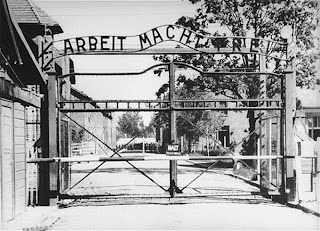 | View of the entrance to the main camp of Auschwitz (Auschwitz I). The gate bears the motto "Arbeit Macht Frei" (Work makes one free). Date: May 11, 1945 - May 15, 1945. Locale: Auschwitz, [Upper Silesia] Poland; Birkenau; Auschwitz III; Monowitz; Auschwitz II. Credit: USHMM, courtesy of Instytut Pamieci Narodowej. Copyright: Public Domain |
In 1872 the German-nationalist author Lorenz Diefenbach used the expression, "Arbeit macht frei," as the title for a novel, causing the expression to become well-known in nationalist circles. It was adopted in 1928 by the Weimar government as a slogan extolling the effects of their desired policy of large-scale public works programmes to end unemployment, and mocking the individualist slogan, "Stadtluft macht frei" ("Urban air liberates"). It was continued in this usage by the NSDAP (Nazi Party) when it came to power in 1933
The slogan, "Arbeit macht frei," was placed at the entrances to a number of Nazi concentration camps, not as a mockery, not even literally – as a false promise that those who worked to exhaustion would eventually be released – but rather "as a kind of mystical declaration that self-sacrifice in the form of endless labour does in itself bring a kind of spiritual freedom." [1]
Although it was common practice in Germany to post inscriptions of this sort at entrances to institutional properties and large estates, the slogan's use in this instance was ordered by SS General Theodor Eicke, inspector of concentration camps and first commandant of Dachau Concentration Camp.
The slogan can still be seen at several sites, including the entrance to Auschwitz I—although, according to Auschwitz: a New History, by BBC historian Laurence Rees, it was placed there by commandant Rudolf Höß, who believed that doing menial work during his own imprisonment under the Weimar Republic had helped him through the experience. At Auschwitz, the upper bowl in the "B" in "ARBEIT" is wider than the lower bowl, appearing to some as upside-down. Several geomerically constructed sans-serif typefaces of the 1920s experimented with this variation.
The slogan can also be seen at the Dachau concentration camp, Gross-Rosen, Sachsenhausen, and the Theresienstadt Ghetto-Camp.
At Buchenwald, however, "Jedem das Seine" ("To each his own") was used instead.
In 1938 the Austrian political cabaret writer Jura Soyfer and the composer Herbert Zipper, while prisoners at Dachau Concentration Camp, wrote the Dachaulied (The Dachau Song). They had spent weeks marching in and out of the camp's gate to daily forced labor, and considered the motto, "Arbeit macht frei," over the gate an insult. The song repeats the phrase cynically as a "lesson" taught by Dachau.
This article is licensed under the GNU Free Documentation License. It uses material from the Wikipedia article, Arbeit macht frei
Presidential Podcast 11/24/07 and Seasons Greetings Horse Drawn Carriage and Make way for the real nanopod













No comments:
Post a Comment